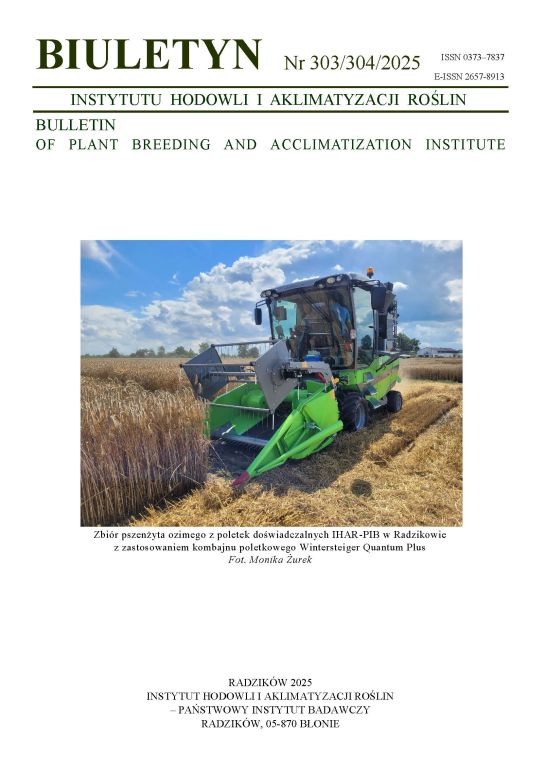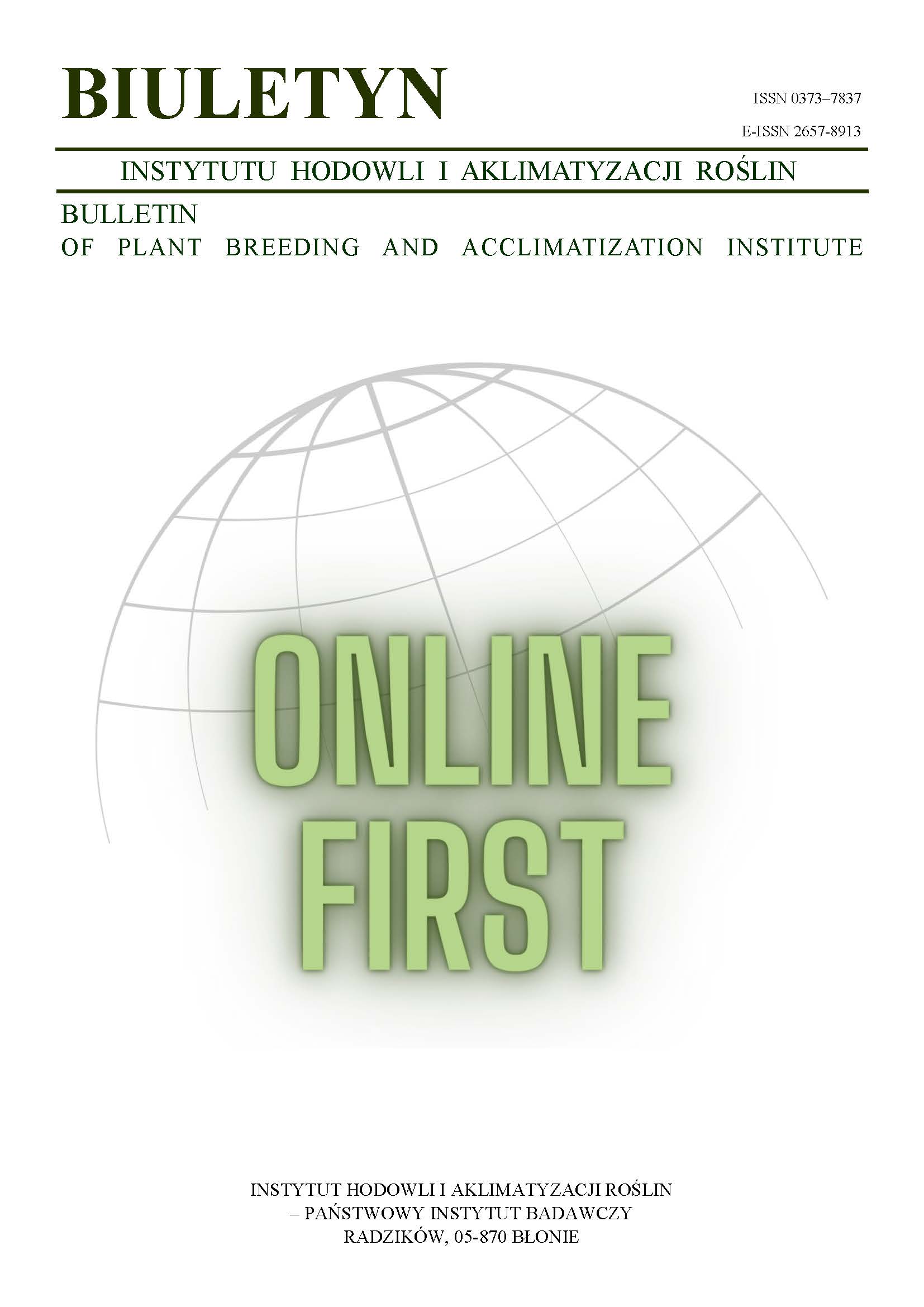Yielding and stability of winter triticale breeding lines and doubled haploids
Wojciech Mikulski
tomasz.dutkiewicz@danko.plHodowla Roślin Szelejewo, Spółka z o.o. (Poland)
Tadeusz Adamski
Instytut Genetyki Roślin PAN, Poznań (Poland)
Zygmunt Kaczmarek
Instytut Genetyki Roślin PAN, Poznań (Poland)
Marcin Konieczny
Hodowla Roślin Szelejewo, Spółka z o.o. (Poland)
Aleksandra Ponitka
Instytut Genetyki Roślin PAN, Poznań (Poland)
Maria Surma
Instytut Genetyki Roślin PAN, Poznań (Poland)
Aurelia Ślusarkiewicz-Jarzina
Instytut Genetyki Roślin PAN, Poznań (Poland)
Abstract
The paper presents studies on yielding of winter triticale breeding lines and doubled haploids (DH) in various environments. Twenty-five breeding lines and five DH lines were examined in field experiments carried out in six localities. Genotype-environment interaction (GE) was computed by the SERGEN programme. Among the studied genotypes only six (5 breeding lines and 1 DH) were characterised by stable yield. Out of 24 genotypes with significant GE interaction four were distinguished as intensive and four as extensive ones. No differences between breeding lines and doubled haploids were found in their reaction to environmental conditions.
Keywords:
triticale, breeding lines, doubled haploids, GE interactionReferences
Caliński T., Czajka S., Kaczmarek Z., Krajewski P., Siatkowski I. 1998. SERGEN. Analiza serii doświadczeń odmianowych i genetyczno-hodowlanych. Wersja 3. Poznań.
Google Scholar
Hu H. 1996. Chromosome engineering in the triticale using pollen-derived plants. In: In vitro haploid production in higher plants, Vol. 2: Applications. Mohan Jain S., Sopory S. K., Veilleux R. E. (eds.). Kluwer Academic Publishers, Dordrecht: 203 — 223.
Google Scholar
Pickering R. A., Devaux P. 1992. Haploid production: Approaches and use in plant breeding. In: Barley genetics, biochemistry, molecular biology and biotechnology. Shewry P. R. (ed.). CAB Int., Wallingford: 519 — 547.
Google Scholar
Simmonds N. W. 1991. Selection for local adaptation in a plant breeding programme. Theor. Appl. Genet. 82: 363 — 367.
DOI: https://doi.org/10.1007/BF02190624
Google Scholar
Soliman K. M., Allard R. W. 1991. Grain yield in composite cross populations of barley: effects of natural selection. Crop Sci. 31: 705 — 708.
DOI: https://doi.org/10.2135/cropsci1991.0011183X003100030032x
Google Scholar
Authors
Tadeusz AdamskiInstytut Genetyki Roślin PAN, Poznań Poland
Authors
Zygmunt KaczmarekInstytut Genetyki Roślin PAN, Poznań Poland
Authors
Marcin KoniecznyHodowla Roślin Szelejewo, Spółka z o.o. Poland
Authors
Aleksandra PonitkaInstytut Genetyki Roślin PAN, Poznań Poland
Authors
Maria SurmaInstytut Genetyki Roślin PAN, Poznań Poland
Authors
Aurelia Ślusarkiewicz-JarzinaInstytut Genetyki Roślin PAN, Poznań Poland
Statistics
Abstract views: 215PDF downloads: 21
License
Copyright (c) 2004 Wojciech Mikulski, Tadeusz Adamski, Zygmunt Kaczmarek, Marcin Konieczny, Aleksandra Ponitka, Maria Surma, Aurelia Ślusarkiewicz-Jarzina

This work is licensed under a Creative Commons Attribution-ShareAlike 4.0 International License.
Upon submitting the article, the Authors grant the Publisher a non-exclusive and free license to use the article for an indefinite period of time throughout the world in the following fields of use:
- Production and reproduction of copies of the article using a specific technique, including printing and digital technology.
- Placing on the market, lending or renting the original or copies of the article.
- Public performance, exhibition, display, reproduction, broadcasting and re-broadcasting, as well as making the article publicly available in such a way that everyone can access it at a place and time of their choice.
- Including the article in a collective work.
- Uploading an article in electronic form to electronic platforms or otherwise introducing an article in electronic form to the Internet or other network.
- Dissemination of the article in electronic form on the Internet or other network, in collective work as well as independently.
- Making the article available in an electronic version in such a way that everyone can access it at a place and time of their choice, in particular via the Internet.
Authors by sending a request for publication:
- They consent to the publication of the article in the journal,
- They agree to give the publication a DOI (Digital Object Identifier),
- They undertake to comply with the publishing house's code of ethics in accordance with the guidelines of the Committee on Publication Ethics (COPE), (http://ihar.edu.pl/biblioteka_i_wydawnictwa.php),
- They consent to the articles being made available in electronic form under the CC BY-SA 4.0 license, in open access,
- They agree to send article metadata to commercial and non-commercial journal indexing databases.
Most read articles by the same author(s)
- Maria Surma, Tadeusz Adamski, Karolina Krystkowiak, Anetta Kuczyńska, Krzysztof Mikołajczak, Piotr Ogrodowicz, Functional markers for quantitative traits , Bulletin of Plant Breeding and Acclimatization Institute: No. 264 (2012): Regular issue
- Laurencja Szała, Zygmunt Kaczmarek, Elżbieta Adamska, Teresa Cegielska-Taras, Influence of the direction of crossing on the expression of seed colour and yield components in DH line populations of winter oilseed rape , Bulletin of Plant Breeding and Acclimatization Institute: No. 264 (2012): Regular issue
- Wojciech Rybiński, Tadeusz Adamski, Maria Surma, Jan Bocianowski, Obtaining of haploids with use of Hordeum bulbosum method and mutagenesis and analysis of quantitative traits variation in spring barley DH lines , Bulletin of Plant Breeding and Acclimatization Institute: No. 275 (2015): Regular issue
- Tadeusz Adamski, Andrzej Bichoński, Zdzisław Biliński, Zbigniew Bystry, Piotr Jarosz, Dorota Jasińska, Zygmunt Kaczmarek, Karolina Krystkowiak, Anetta Kuczyńska, Wojciech Mikulski, Barbara Nowak, Wanda Orłowska-Job, Zdzisław Paszkiewicz, Michał Rębarz, Maria Surma, Anna Sybilska, Renata Trzeciak, The genotype-environment interaction for barley lines from different breeding stations , Bulletin of Plant Breeding and Acclimatization Institute: No. 249 (2008): Regular issue
- Tadeusz Adamski, Zygmunt Kaczmarek, Maria Surma, Anetta Kuczyńska, Karolina Krystkowiak, Bolesław Salmanowicz, Renata Trzeciak, Zofia Banaszak, Bogusława Ługowska, Małgorzata Majcher, Wiktor Obuchowski, Multivariate analysis of some quality traits of winter wheat grain , Bulletin of Plant Breeding and Acclimatization Institute: No. 260/261 (2011): Regular issue
- Maria Surma, Tadeusz Adamski, Anetta Kuczyńska, Karolina Krystkowiak, Renata Trzeciak, Krzysztof Mikołajczak, Piotr Ogrodowicz, Modified single seed descent technique in winter barley breeding , Bulletin of Plant Breeding and Acclimatization Institute: No. 262 (2011): Regular issue
- Katarzyna Pankiewicz, Wojciech Rybiński, Zygmunt Kaczmarek, Estimation of variability on phenotypic and molecular level of spherical-seeded form of grasspea (Lathyrus sativus L.) , Bulletin of Plant Breeding and Acclimatization Institute: No. 260/261 (2011): Regular issue
- Anita Dobek, Jan Bocianowski, Ewa Bakinowska, Wiesław Pilarczyk, Wojciech Mikulski, Jacek Kaczmarek, Problems related to testing of cereal lines at early stages of plant breeding , Bulletin of Plant Breeding and Acclimatization Institute: No. 249 (2008): Regular issue
- Halina Wiśniewska, Tomasz Góral, Piotr Ochodzki, Dorota Walentyn-Góral, Michał Kwiatek, Maciej Majka, Jolanta Belter, Zofia Banaszak, Mirosław Pojmaj, Danuta Kurleto, Marcin Konieczny, Grzegorz Budzianowski, Alicja Cicha, Kazimierz Paizert, Przemysław Matysik, Evaluation of Fusarium head blight resistance types in winter triticale using phenotypic and metabolic markers , Bulletin of Plant Breeding and Acclimatization Institute: No. 284 (2018): Regular issue
- Tadeusz Adamski, Maria Surma, Aleksandra Ponitka, Aurelia Ślusarkiewicz-Jarzina, Karolina Krystkowiak, Anetta Kuczyńska, Hanna Pudelska, Krzysztof Rubrycki, Renata Trzeciak, Jolanta Woźna, Production efficiency of wheat haploids by anther culture and wheat × maize crosses , Bulletin of Plant Breeding and Acclimatization Institute: No. 252 (2009): Regular issue














